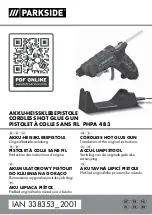
6
•
Avoid prolonged contact with dust from power sanding, sawing, grinding,
drilling, and other construction activities. Wear protective clothing and wash
exposed areas with soap and water.
Allowing dust to get into your mouth, eyes,
or lay on the skin may promote absorption of harmful chemicals.
WARNING:
Use of this tool can generate and/or disburse dust, which may cause
serious and permanent respiratory or other injury. Always use NIOSH/OSHA approved
respiratory protection appropriate for the dust exposure. Direct particles away from
face and body.
WARNING:
ALWAYS USE SAFETY GLASSES. Everyday eyeglasses are NOT safety
glasses. Also use face or dust mask if operation is dusty. ALWAYS WEAR CERTIFIED
SAFETY EQUIPMENT:
• ANSI Z87.1 eye protection (CAN/CSA Z94.3),
• ANSI S12.6 (S3.19) hearing protection,
• NIOSH/OSHA/MSHA respiratory protection.
CAUTION:
When not in use, place tool on its side on a stable surface where it will
not cause a tripping or falling hazard.
Some tools with large battery packs will stand
upright on the battery pack but may be easily knocked over.
• The label on your tool may include the following symbols. The symbols and their
definitions are as follows:
V ............volts
A .................amperes
Hz ..........hertz
W ................watts
min ........minutes
.............alternating current
...direct current
no ...............no load speed
.........Class I Construction
..............safety alert symbol
..............
(grounded)
…/min ........revolutions or reciprocation
..........earthing terminal
...................
per minute
.........Class II Construction
BPM ............beats per minute
..............
(double insulated)
BEFORE OPERATING THIS TOOL, CAREFULLY READ AND UNDERSTAND ALL
INSTRUCTIONS IN THE “IMPORTANT SAFETY INSTRUCTIONS” SECTION.
Important Safety Instructions for Battery Packs
Your tool uses a D
E
WALT battery pack. When ordering replacement battery packs, be
sure to include catalog number and voltage: Extended Run-Time battery packs deliver
more run-time than standard battery packs. Consult the chart at the end of this manual
for compatibility of chargers and battery packs.
NOTE:
Your tool will accept either standard or Extended Run Time battery packs.
However, be sure to select proper voltage. Batteries slowly lose their charge when
they are not on the charger, the best place to keep your battery is on the charger at all
times.
The battery pack is not fully charged out of the carton. Before using the battery pack
and charger, read the safety instructions below, then follow charging procedures
outlined.
READ ALL INSTRUCTIONS
•
Do not incinerate the battery pack even if it is severely damaged or is
completely worn out.
The battery pack can explode in a fire.
• A small leakage of liquid from the battery pack cells may occur under extreme
usage or temperature conditions.
This does not indicate a failure.
However, if the outer seal is broken:
a. and the battery liquid gets on your skin, immediately wash with soap
and water for several minutes.
b. and the battery liquid gets into your eyes, flush them with clean water
for a minimum of 10 minutes and seek immediate medical attention.
(
Medical note
:
The liquid is 25-35% solution of potassium hydroxide.)
• Charge the battery packs only in D
E
WALT chargers.
•
DO NOT
splash or immerse in water or other liquids.
• Do not store or use the tool and battery pack in locations where the
temperature may reach or exceed 40
˚
C (105°F) (such as outside sheds or
metal buildings in summer).
DANGER:
Electrocution hazard. Never attempt to open the battery pack for any
reason. If battery pack case is cracked or damaged, do not insert into charger. Electric
shock or electrocution may result. Damaged battery packs should be returned to
service center for recycling.






































